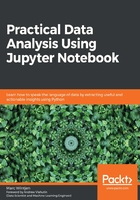
Summary
Let's look back at what we learned in this chapter and the skills obtained before we move forward. First, we covered a brief history of data analysis and the technological evolution of data by paying homage to the people and milestone events that made working with data possible using modern tools and techniques. We walked through an example of how to summarize these events using a data visual trend chart that showed how recent technology innovations have transformed the data industry.
We focused on why data has become important to make decisions from both a consumer and producer perspective by discussing the concepts for identifying and classifying data using structured, semi-structured, and unstructured examples and the 3Vsof big data: Volume, Velocity, and Variety.
We answered the question of what makes a good data analyst using the techniques of KYD, VOC, and ABA.
Then, we went deeper into understandingdata types by walking through the differences between numbers (integer and float) versus strings (text, time, dates, and coordinates). This includedbreaking down data classifications (continuous, categorical, and discrete) and understanding data attribute types.
We wrapped up this chapter by introducing the concept of data literacyand its importance to the consumers and producers of data by improving communication between them.
In our next chapter,we will get more hands-on by installing and setting up an environment for data analysis and so begin the journey of applying the concepts learned about data.